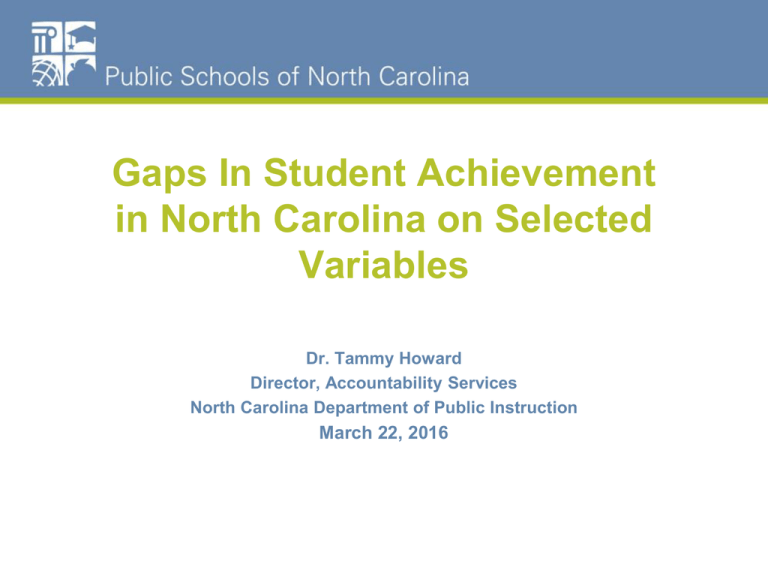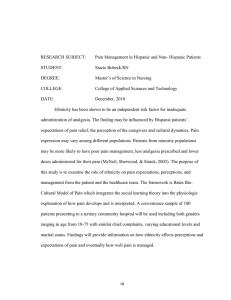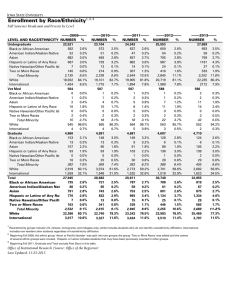Gaps In Student Achievement in North Carolina on Selected Variables March 22, 2016
advertisement

Gaps In Student Achievement in North Carolina on Selected Variables Dr. Tammy Howard Director, Accountability Services North Carolina Department of Public Instruction March 22, 2016 Presentation Areas • • • • • • • • • • • National Assessment of Education Progress (NAEP) End-of-Grade (EOG) Assessments End-of-Course (EOC) Assessments ACT Advanced Placement (AP) Cohort Graduation Rates Short-Term and Long-Term Suspensions and Expulsions Educator Equity Plan Recommendations Selected References and Research Studies Contact Information 2 3 The Gold Standard National Assessment of Educational Progress (NAEP) 2015 Statistic Summary Compared with 2013 North Carolina Performance Compared to the Nation’s Public Schools READING 2013 2015 Grade 4 Scale Scores Grade 8 Scale Scores MATHEMATICS 2013 2015 222 226 ▲ 245 244 = 265 261 ▼ 286 281 ▼ 69% 73% = 87% 85% = Grade 4 At or above Basic Legend Above the Nation (statistically) Same as the Nation (statistically) Grade 8 At or above Basic 76% 72% = 75% 69% = ▲ Grade 4 At or above Proficient 35% 38% = 45% 44% = 33% 30% = 36% 33% = Grade 8 At or above Proficient = ▼ Below the Nation (statistically) NC Score/percentages in 2015 higher (statistically) than previous administration (2013) NC Score/percentages in 2015 same (statistically) as previous administration (2013) NC Score/percentages in 2015 lower (statistically)than previous administration (2013) 4 NAEP Mathematics Grade 4 ─ Race/Ethnicity/Overall Percent At or Above Basic: 2000-2015 100 90 80 Percentage 70 60 50 40 30 20 10 0 2000 NP Overall 2003 NC Overall 2005 White 2007 Black 2009 Hispanic Asian 2011 American Indian 2013 2015 2 or More Races NOTE: Observed differences are not necessarily statistically significant. SOURCE: U.S. Department of Education, Institute of Education Sciences, National Center for Education Statistics, National Assessment of Educational Progress (NAEP). 5 NAEP Mathematics Grade 4 ─ Race/Ethnicity/Overall Percent At or Above Proficient: 2000-2015 100 90 80 Percentage 70 60 50 40 30 20 10 0 2000 NP Overall 2003 NC Overall 2005 White 2007 Black 2009 Hispanic Asian 2011 American Indian 2013 2015 2 or More Races NOTE: Observed differences are not necessarily statistically significant. SOURCE: U.S. Department of Education, Institute of Education Sciences, National Center for Education Statistics, National Assessment of Educational Progress (NAEP). 6 NAEP Reading Grade 4 ─ Race/Ethnicity/Overall Percent At or Above Basic: 2003-2015 100 90 80 Percentage 70 60 50 40 30 20 10 0 2000 NP Overall 2003 NC Overall 2005 White 2007 Black 2009 Hispanic Asian 2011 American Indian 2013 2015 2 or More Races NOTE: Observed differences are not necessarily statistically significant. SOURCE: U.S. Department of Education, Institute of Education Sciences, National Center for Education Statistics, National Assessment of Educational Progress (NAEP). 7 NAEP Reading Grade 4 ─ Race/Ethnicity/Overall Percent At or Above Proficient: 2003-2015 100 90 80 Percentage 70 60 50 40 30 20 10 0 2000 NP Overall 2003 NC Overall 2005 White 2007 Black 2009 Hispanic Asian 2011 American Indian 2013 2015 2 or More Races NOTE: Observed differences are not necessarily statistically significant. SOURCE: U.S. Department of Education, Institute of Education Sciences, National Center for Education Statistics, National Assessment of Educational Progress (NAEP). 8 NAEP Mathematics Grade 8 ─ Race/Ethnicity/Overall Percent At or Above Basic: 2000-2015 100 90 80 Percentage 70 60 50 40 30 20 10 0 2000 NP Overall 2003 NC Overall 2005 White 2007 Black 2009 Hispanic Asian 2011 American Indian 2013 2015 2 or More Races NOTE: Observed differences are not necessarily statistically significant. SOURCE: U.S. Department of Education, Institute of Education Sciences, National Center for Education Statistics, National Assessment of Educational Progress (NAEP). 9 NAEP Mathematics Grade 8 ─ Race/Ethnicity/Overall Percent At or Above Proficient: 2000-2015 100 90 80 Percentage 70 60 50 40 30 20 10 0 2000 NP Overall 2003 NC Overall 2005 White 2007 Black 2009 Hispanic Asian 2011 American Indian 2013 2015 2 or More Races NOTE: Observed differences are not necessarily statistically significant. SOURCE: U.S. Department of Education, Institute of Education Sciences, National Center for Education Statistics, National Assessment of Educational Progress (NAEP). 10 NAEP Reading Grade 4 ─ Race/Ethnicity/Overall Percent At or Above Basic: 2003-2015 100 90 80 Percentage 70 60 50 40 30 20 10 0 2000 NP Overall 2003 NC Overall 2005 White 2007 Black 2009 Hispanic Asian 2011 American Indian 2013 2015 2 or More Races NOTE: Observed differences are not necessarily statistically significant. SOURCE: U.S. Department of Education, Institute of Education Sciences, National Center for Education Statistics, National Assessment of Educational Progress (NAEP). 11 NAEP Reading Grade 8 ─ Race/Ethnicity/Overall Percent At or Above Proficient: 2003-2015 100 90 80 Percentage 70 60 50 40 30 20 10 0 2000 NP Overall 2003 NC Overall 2005 White 2007 Black 2009 Hispanic Asian 2011 American Indian 2013 2015 2 or More Races NOTE: Observed differences are not necessarily statistically significant. SOURCE: U.S. Department of Education, Institute of Education Sciences, National Center for Education Statistics, National Assessment of Educational Progress (NAEP). 12 13 14 15 16 17 18 19 20 21 22 23 24 25 26 27 28 EOG Assessments 29 Percent Proficient on Math EOG Grades 3-8 By Race College and Career Readiness Standard 80.0 71.2 72.4 73.3 53.8 54.8 56.1 70.0 60.0 50.0 40.0 30.0 20.0 43.1 42.3 44.1 42.0 32.7 27.0 33.5 27.0 34.5 42.6 27.3 22.2 22.9 24.2 2013 2014 2015 42.4 10.0 0.0 All Students American Indian Asian Black Hispanic Two or More Races White 30 Percent Proficient on Math EOG Grades 3-8 Disadvantaged Subgroup Comparison College and Career Readiness Standard 80.0 70.0 60.1 61.3 46.8 47.3 59.3 60.0 50.0 30.0 20.0 45.7 44.6 43.8 40.0 49.0 42.3 27.7 43.1 28.2 44.1 29.1 17.4 12.4 17.9 12.5 18.9 2013 2014 2015 13.0 10.0 0.0 All Students Limited English Proficient Economically Disadvantaged Students with Disabilities 31 2014-15 Percent Proficient on Math EOG Grades 3-8 Race and Disadvantaged Status College and Career Readiness Standard 90.0 82.2 80.5 76.1 80.0 70.0 65.0 56.2 52.1 50.0 40.0 61.5 57.2 60.0 47.4 45.7 36.9 42.442.8 39.4 37.2 35.2 30.931.1 30.0 21.0 27.4 38.0 30.6 24.2 19.9 19.1 20.0 30.7 27.8 24.4 22.6 19.2 16.3 9.6 10.0 9.9 18.7 12.8 5.7 0.0 NOT Economically Disadvantaged Economically Disadvantaged American Indian NOT Limited English Proficient Asian Black Limited English Proficient Hispanic Two or More Races NOT Students With Disabilities Students With Disabilities White 32 Percent Proficient on Reading EOG Grades 3-8 By Race College and Career Readiness Standard 80.0 70.0 63.0 57.8 64.5 60.0 61.5 56.6 50.0 45.7 46.1 45.9 40.0 43.9 29.0 44.7 29.2 45.1 30.0 58.4 30.0 28.6 28.8 20.0 25.6 26.3 2013 2014 28.8 26.7 10.0 0.0 All Students American Indian Asian Black 2015 Hispanic Two or More Races White 33 Percent Proficient on Reading EOG Grades 3-8 Disadvantaged Subgroup Comparison College and Career Readiness Standard 80.0 70.0 62.5 63.7 48.7 49.1 60.7 60.0 50.0 50.0 47.2 46.1 40.0 30.0 20.0 46.8 45.1 29.7 43.9 28.7 44.7 29.3 12.9 13.2 13.5 9.4 10.3 10.6 2013 2014 2015 10.0 0.0 All Students Economically Disadvantaged Limited English Proficient NOT Economically Disadvantaged NOT Limited English Proficient Not Students With Disabilities Students with Disabilities 34 2014-15 Percent Proficient on Reading EOG Grades 3-8 Race and Disadvantaged Status College and Career Readiness Standard 90.0 80.0 74.8 73.6 67.2 66.7 70.0 59.6 60.0 64.0 58.6 51.0 50.0 40.0 38.6 43.4 39.2 30.0 46.1 40.2 22.0 40.6 35.1 25.7 21.9 39.1 28.9 32.3 26.8 21.7 20.0 18.9 14.9 13.6 9.2 10.0 33.2 30.5 19.3 14.0 17.3 9.3 9.0 7.5 7.8 0.0 NOT Economically Disadvantaged Economically Disadvantaged American Indian NOT Limited English Proficient Asian Black Limited English Proficient Hispanic Two or More Races NOT Students With Disabilities Students With Disabilities White 35 Percent Proficient on Science EOG Grades 5 & 8 College and Career Readiness Standard 80 70.5 70 78.3 76.2 71.6 70.2 64.7 61.5 58.8 60 54.1 59.1 57.3 50 52.2 46.8 45 46.5 39.9 40 41.5 39.5 39.5 30 36.7 32.6 20 2013 All Students 2014 American Indian Asian Black 2015 Hispanic Two or More Races White 36 Percent Proficient on Science EOG Grades 5 & 8 Disadvantaged Subgroup Comparison College and Career Readiness Standard 80.0 74.7 73.1 69.5 70.0 64.6 61.9 57 60.0 54.2 50.0 59.1 44.5 57.3 42.4 52.2 37.6 40.0 61 59.1 30.0 23.4 24.3 16.4 17.3 18.7 2013 2014 2015 20.6 20.0 10.0 0.0 All Students Economically Disadvantaged Limited English Proficient NOT Economically Disadvantaged NOT Limited English Proficient NOT Students With Disabilities Students with Disabilities 37 2014-15 Percent Proficient on Science EOG Grades 5 & 8 Race and Disadvantaged Status College and Career Readiness Standard 90.0 86.4 86.0 80.8 78.4 73.6 80.0 76.9 71.7 67.1 70.0 60.0 57.6 59.2 59.9 61.7 56.6 56.4 51.5 53.1 52.2 46.8 50.0 42.5 38.3 40.0 51.1 44.9 39.6 33.9 31.0 30.4 27.5 25.9 22.2 16.6 30.0 20.0 29.8 16.9 33.6 26.5 17.4 13.7 10.0 0.0 NOT Economically Disadvantaged Economically Disadvantaged American Indian NOT Limited English Proficient Asian Black Limited English Proficient Hispanic Two or More Races NOT Students With Disabilities Students With Disabilities White 38 EOC Assessments 39 Percent Proficient on 2015 End of Course Assessments By Race College and Career Readiness Standard 78.2 80 70 67.5 64.1 61.9 60.2 60 50 57.2 48.6 46.4 40 45.0 44.9 38.9 37.1 26.3 33.9 32.8 32.1 30.1 30 52.2 50 31.3 24.8 20 10 0 Math 1 Biology All Students American Indian Asian Black English 2 Hispanic Two or More Races White 40 Percent Proficient on 2015 End of Course Assessments Disadvantaged Subgroup Comparison College and Career Readiness Standard 70 62.9 62.2 60 57.4 54.8 52.8 50 50 48.6 48.7 51.4 50 45.9 44.9 40 33.8 30.5 28.9 30 20 13.6 12.5 10.6 10.8 10 7.5 <5 0 Math 1 Biology All Students Economically Disadvantaged Limited English Proficient Not Economically Disadvantaged Not Limited English Proficient Not Students with Disabilities English 2 Students with Disabilities 41 ACT 42 80.0 75.0 70.0 Percent of Students Scoring at Least UNC Minimum Composite (17) Grade 72.5 11 ACT 73.6 71.9 73.5 72.5 71.9 65.0 61.2 60.0 59.9 60.0 55.0 58.5 59.3 59.7 45.4 44.9 50.0 45.0 40.0 35.0 44.2 44.5 43.9 42.9 35.0 34.9 33.4 30.0 2013 All Students American Indian Asian 2014 Black Hispanic Two or More Races 2015 White 43 Advanced Placement (AP) 44 NC Public School AP Data - 2015 • North Carolina saw growth in all three major categories of AP Participation and Performance: – 18.7% increase of exam takers over last year (67,678 students) – 19.1% increase of exams taken over last year (125,547 exams) – 9.0% increase of examinees attained 3+ score over last year (63,837 exams) AP Participation - NC Public School Students Number AP Exams 120,000 100,000 Number Students 80,000 60,000 40,000 20,000 0 2011 2014 2015 45 Racial Participation & Performance Gains 46 AP Exam Performance • 53.9% of public school AP Exam takers scored 3 or higher on at least one AP Exam in May 2015 – 28.1% of Black examinees scored 3 or higher. – 45.5% of Hispanic examinees scored 3 or higher – 30.7% of Native American examinees scored 3 or higher. • Represents 36,504 public school students, compared to 33,307 in 2014 and 27,093 in 2011. 47 Cohort Graduation Rates 48 4-Yr Cohort Graduation Rate 2006-2015 100 95 90 85 80 75 70 65 60 55 50 2006 2007 2008 2009 2010 2011 2012 2013 2014 2015 All Students 68.3 69.5 70.3 71.8 74.2 77.9 80.4 82.5 83.9 85.6 American Indian 51.1 55.6 53.8 60 68 69.7 73.7 77.3 79.4 82 Asian 75.2 78.9 81 83.7 85.2 86.9 87.5 89.9 91.3 92.1 Black 60.4 61.4 62.7 63.2 66.9 71.5 74.7 77.5 79.9 82.2 Hispanic 52.3 53.7 56.4 59 61.4 68.8 73 75.2 77.4 80 66 65.4 68.4 71.5 71.1 77.2 80.6 81.5 82.7 84.5 73.5 75 75.7 77.7 79.6 82.6 84.7 86.2 87.1 88.3 Two or More Races White 49 Short-Term and Long-Term Suspensions and Expulsions (http://www.ncpublicschools.org/docs/research/discip line/reports/consolidated/2013-14/consolidatedreport.pdf) 50 Short-Term Suspensions by Race/Ethnicity Note: Race/Ethnicity was not reported or was reported as “Other” for 1,776 short-term suspensions in 2009-10, 77 in 2010-11, 110 in 2011-12, 264 in 2012-13, and 264 in 2013-14. 51 Short-Term Suspensions by Race/Ethnicity Note: Race/Ethnicity was not reported or was reported as “Other” for 1,776 short-term suspensions in 2009-10, 77 in 2010-11, 110 in 2011-12, 264 in 2012-13, and 264 in 2013-14. Rates calculated by dividing number of suspensions in race/ethnicity category by membership in that race/ethnicity category and multiplying by ten. 52 Short-Term Suspensions by Race/Ethnicity and Gender Note: Race/Ethnicity was not reported or was reported as “Other” for 1,776 short-term suspensions in 2009-10, 77 in 2010-11, 110 in 2011-12, 264 in 2012-13, and 264 in 2013-14. Rates calculated by dividing number of suspensions in race/ethnicity category by membership in that race/ethnicity category and multiplying by ten. 53 Short-Term Suspensions by Race/Ethnicity and Gender Note: Race/Ethnicity was not reported or was reported as “Other” for 1,776 short-term suspensions in 2009-10, 77 in 2010-11, 110 in 2011-12, 264 in 2012-13, and 264 in 2013-14. Rates calculated by dividing number of suspensions in race/ethnicity category by membership in that race/ethnicity category and multiplying by ten. 54 Long-Term Suspensions by Race/Ethnicity Note: Race/Ethnicity was not reported or was reported as “Other” for 44 long-term suspensions in 2009-10, two in 2010-11, five in 2012-13, and 43 in 2013-14. 55 Long-Term Suspensions by Race/Ethnicity Note: Race/Ethnicity was not reported or was reported as “Other” for 44 long-term suspensions in 2009-10, two in 2010-11, five in 2012-13, and 43 in 2013-14. Rates calculated by dividing number of suspensions in race/ethnicity category by membership in that race/ethnicity category and multiplying by 100,000. 56 Long-Term Suspensions by Race/Ethnicity and Gender Note: Rates calculated by dividing number of suspensions in race/ethnicity*gender category by membership in that race/ethnicity*gender category and multiplying by 100,000. 57 Long-Term Suspensions by Race/Ethnicity and Gender Note: Rates calculated by dividing number of suspensions in race/ethnicity*gender category by membership in that race/ethnicity*gender category and multiplying by 100,000. 58 Expulsions by Gender 59 Expulsions by Race/Ethnicity 60 Educator Equity Plan 61 Educator Equity Plan • • • • Required by the former ESEA Involved Stakeholder Input NC’s Plan Submitted on June 1, 2015 Finally Approved by the USED on November 18, 2015 after Two Rounds of Revisions • The Educator Equity Plan Can Be Found at http://www.ncpublicschools.org/docs/program -monitoring/titleIA/equity-plan/equity- final.pdf 62 Educator Equity Plan Strategies Included in Plan: 1) NC Virtual Public Schools 2) Expansion of Access to Teacher Preparation Programs 3) Teacher and Administrator Preparation Programs 4) Troops to Teachers 5) Regional Leadership Academies 6) Mentoring and Induction into Teaching 7) Performance-Based Teacher and Principal Evaluation 8) Financial Incentives 63 Educator Equity Plan Strategies Included in Plan: 9) 10) 11) 12) 13) 14) 15) 16) 17) Teacher Working Conditions National Board Certification High-Quality Professional Development Expansion of the Turnaround Teams for LowPerforming Schools Technology Integration Microsoft IT Academy LEA Educator Equity Plans Focus on Teacher Retention Public Reporting 64 Figure 3 Teacher Effectiveness by Quartiles of Economically Disadvantaged Students (EDS) 18% 16.69% Quartile Range - EDS 16% 13.51% 14% 13.28% Percentage of Teachers 12.17% 11.42% 12% 10.75% Q1 Q2 Q3 Q4 0 - 43.4% 43.5 - 59.2% 59.3 - 74.8% 74.9 - 98.8% 10% 8% 7.64% 7.08% Percent Teachers Designated as "Highly Effective" 6% 4% Percent Teachers Designated as "Needs Improvement" 2% 0% EDS_Q1 EDS_Q2 EDS_Q3 EDS_Q4 Note: Teacher Effectiveness is determined using NC Educator Effectiveness guidelines. Teachers’ observational data (2013-14 school year) are combined with a three year average (2011-12 through 2013-14 school years) of the teacher student-growth data. These ratings are not official teacher ratings as the 2011-12 data are not formally used for determining teacher effectiveness. These data serve as a baseline for future analyses. 65 Figure 4 Teacher Effectiveness by Quartiles of Minority Students 16% 14.24% Quartile Range - Minority 14.55% 14% 13.09% 12.15% Percentage of Teachers 12% 11.53% 9.87% 10% 8% Q1 Q2 Q3 Q4 0 - 25.4% 25.5 - 45.6% 45.7 - 69.3% 69.4 - 100.0% 9.42% 7.85% 6% Percent Teachers Designated as "Highly Effective" 4% Percent Teachers Designated as "Needs Improvement" 2% 0% MINORITY_Q1 MINORITY_Q2 MINORITY_Q3 MINORITY_Q4 Note: Teacher Effectiveness is determined using NC Educator Effectiveness guidelines. Teachers’ observational data (2013-14 school year) are combined with a three year average (2011-12 through 2013-14 school years) of the teacher student-growth data. These ratings are not official teacher ratings as the 2011-12 data are not formally used for determining teacher effectiveness. These data serve as a baseline for future analyses. 66 Recommendations (To Name a Few) • • • • • Extend the School Day Extend the School Year Preschool Education 11 Month Contracts for Teachers Targeted Professional Development for Teachers and Administrators • Additional Resources 67 Selected References and Research Studies • An annotated bibliography about the achievement gap prepared by the Division of Data, Research and Federal Policy at the North Carolina Department of Public Instruction can be found at http://www.ncpublicschools.org/aer/achiev ement-nc/ 68 Contact Information • Dr. Louis M. (Lou) Fabrizio Director, Division of Data, Research and Federal Policy, NCDPI lou.fabrizio@dpi.nc.gov • Dr. Vinetta Bell Research Associate, Division of Data, Research and Federal Policy, NCDPI vinetta.bell@dpi.nc.gov • Dr. Tammy Howard Director, Division of Accountability Services, NCDPI tammy.howard@dpi.nc.gov 69







